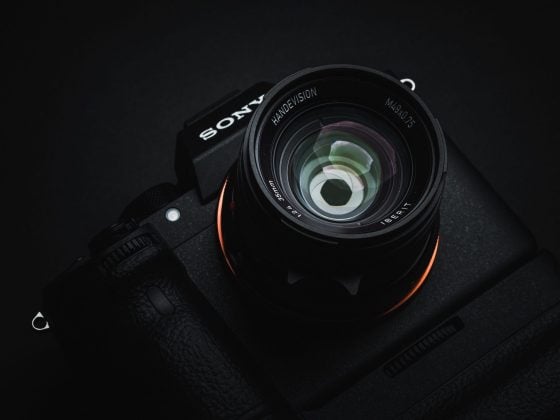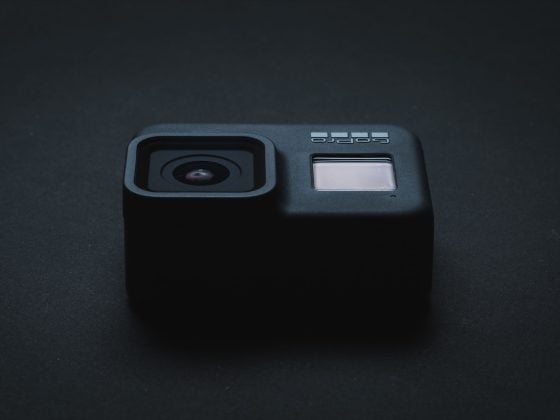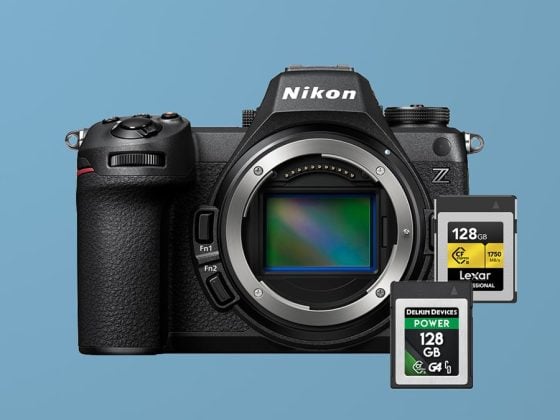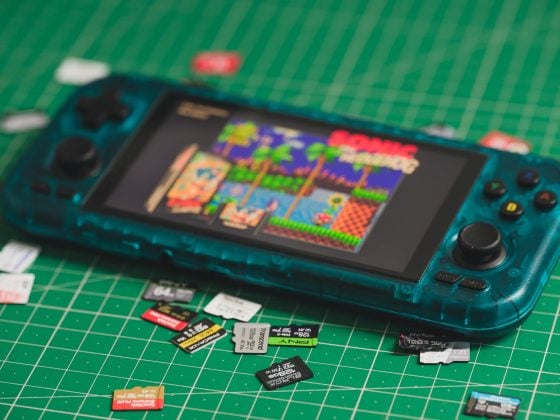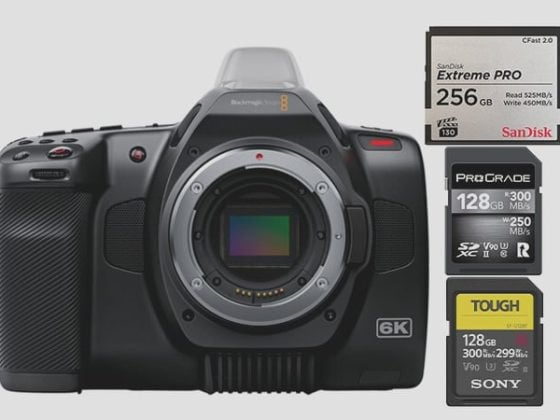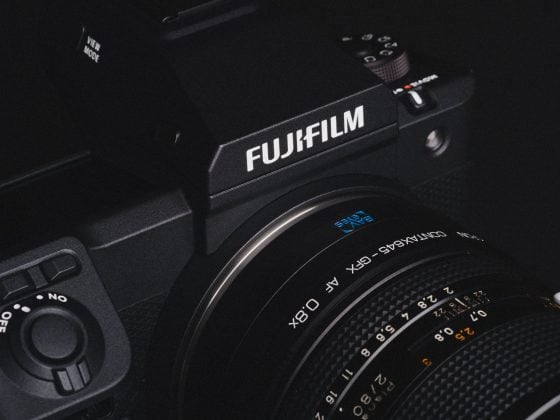To find the best memory card for the Sony A6100, we tested 39 SD memory cards.
It seems like Sony has made the A6100 a bit more user-friendly with the way memory cards are working. It uses UHS-I cards and requires U3 or V30 cards at a minimum size of 64GB to take advantage of all the video features.
Sony A6100 Memory Card Recommendations
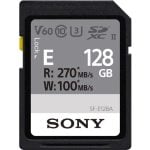 The Sony A6100 uses a single UHS-I memory card slot with a top write speed of about 38.5MB/s.
The Sony A6100 uses a single UHS-I memory card slot with a top write speed of about 38.5MB/s.
Sony 4k video has a compression of 400Mbps, which translates to 12MB/s. Any UHS-I memory card will work for 4k video as long as it’s of the U3, or V30 speed class. Do not use U1 cards.
The Sony A6100 can use memory cards from 8GB in size up to 1TB or larger. There is no set limit to the size of cards this camera can use.
You can use UHS-II memory cards like the Sony E-card. You won’t gain any speed in-camera, but you can get fast transfer speeds from your card to your computer if you use a UHS-II memory card reader. This is useful if you’re using your camera for a lot of video recording.
| Recommended SD Cards | Speed Class | USB Write | USB Read | Links | |
|---|---|---|---|---|---|
| SD UHS-II V60 | UHS-II | Hide | Hide | ||
| Sony E v60 256GB | UHS-II | https://geni.us/ARfXs | Amazon / B&H | ||
| UHS-I U3 | UHS-I | Hide | Hide | ||
| Sandisk Extreme Pro 32/64/128GB | UHS-I | 144 | 172 | https://geni.us/AjId | Amazon / B&H |
| Kingston CanvasGo! 128/256/512GB | UHS-I | 124 | 161 | https://geni.us/oJU7q | B&H |
| Sony 95 | UHS-I | 81 | 90 | https://geni.us/wnX8rG | Amazon |
| Delkin Advantage 32-1TB | UHS-I | 77 | 93 | https://geni.us/HlTWWVh | Amazon / B&H |
Also, see my list of the Essential A6100 Accessories.
Look at this guide to see the newest SD memory card speed tests. Or look at this guide to Memory Cards for Sony Cameras, to see how other Sony cameras are doing.
Memory Card Speed Test | In-Camera Test Results
To test the cards in the camera we do a series of continuous bursts at the fastest speed possible. The time for the buffer to empty is then measured against how much data was written. We repeat this a few times for each card to check for any errors and then get the best results. These are older cards now, but I leave the chart here so you can see the camera speeds and where they cap out.
Even though UHS-II cards are slightly faster, you’ll still want to use UHS-I cards for the A6100.
| Memory Card | Speed Class | In-Camera Write | USB Read | USB Write |
|---|---|---|---|---|
| Sandisk Extreme Pro 170MB/s | UHS-I | 38.51MB/s | 99.2 | 88.3 |
| Sandisk Extreme Plus | UHS-I | 38.55MB/s | 99.3 | 88.2 |
| Sandisk Extreme U3 | UHS-I | 38.23MB/s | 99.3 | 56.8 |
| Sandisk Ultra U1 | UHS-I | 26.01MB/s | 99.5 | 34.3 |
| Kingston Canvas React A1 U3 | UHS-I | 36.66MB/s | 99.6 | 82.5 |
| Kingston Canvas Go! U3 | UHS-I | 36.61MB/s | 99.6 | 74.0 |
| Lexar 633x U1 | UHS-I | 36.63MB/s | 95.0 | 54.6 |
| Sony Professional U3 | UHS-I | 38.83MB/s | 98.5 | 60.2 |
| Sony U3 94MB/s | UHS-I | 37.40MB/s | 96.7 | 57.5 |
| Sony U3 95MB/s | UHS-I | 37.84MB/s | 96.6 | 85.4 |
| Transcend U3 | UHS-I | 38.12MB/s | 96.7 | 87.8 |
| PNY Elite Performance U3 | UHS-I | 38.28MB/s | 96.7 | 66.9 |
| Delkin Advantage U3 | UHS-I | 37.10MB/s | 99.6 | 78.8 |
| Toshiba Exceria Pro U3 | UHS-I | 38.59MB/s | 97.8 | 74.7 |
| Toshiba Exceria U3 | UHS-I | 28.41MB/s | 97.2 | 29.9 |
| Verbatim Pro+ U3 | UHS-I | 37.13MB/s | 98.5 | 83.7 |
| Verbatim Pro U3 | UHS-I | 36.30MB/s | 96.6 | 68.0 |
| Amplim 667x A1 V30 | UHS-I | 35.58MB/s | 99.6 | 52.2 |
| Sandisk Extreme Pro 300MB/s | UHS-II | 39.01MB/s | 258.5 | 190.5 |
| Lexar 2000x | UHS-II | 38.31MB/s | 258.9 | 201.5 |
| Lexar 1000x | UHS-II | 38.45MB/s | 153.4 | 83.09 |
| Toshiba Exceria Pro | UHS-II | 38.81MB/s | 263.6 | 223.8 |
| Transcend v90 | UHS-II | 38.78MB/s | 258.2 | 164.9 |
| Sony G Tough | UHS-II | 39.28MB/s | 256.8 | 201.0 |
| Sony G | UHS-II | 39.29MB/s | 258.0 | 206.7 |
| Sony M | UHS-II | 39.03MB/s | 253.6 | 91.6 |
| Delkin Power v90 | UHS-II | 39.05MB/s | 257.6 | 191.0 |
| Delkin Prime v60 | UHS-II | 39.00MB/s | 252.8 | 89.1 |
| Fujifilm Elite II | UHS-II | 38.89MB/s | 259.3 | 168.4 |
| Adata v90 | UHS-II | 38.64MB/s | 259.4 | 187.4 |
| Hoodman Steel 2000x | UHS-II | 38.63MB/s | 268.7 | 183.9 |
| Hoodman Steel 1500x | UHS-II | 38.87MB/s | 258.1 | 169.2 |
| ProGrade V90 | UHS-II | 39.01MB/s | 258.2 | 212.8 |
| ProGrade V60 | UHS-II | 38.53MB/s | 166.9 | 105.9 |
| Amplim 1900x V60 | UHS-II | 38.76MB/s | 249.8 | 104.5 |
| Angel Bird V90 | UHS-II | 38.74MB/s | 256.6 | 211.1 |
| Angel Bird V60 | UHS-II | 38.50MB/s | 166.9 | 80.2 |
| FreeTail Evoke Pro V60 | UHS-II | 38.71MB/s | 238.5 | 102.8 |
Sony A6100 Camera Specs and Buffer Questions
| Sensor: 24.2MP APS-C Processor: BIONZ X Continuous Burst: 11 fps How Many SD Card Slots? Single Slot, UHS-I Video Modes: 4k24p / 4k25p / 4k30p 100Mbps What Is The Buffer Size? 800MB Estimate How Many Shots To Fill Buffer? 33 RAW How Long To Clear Buffer? 17:49 Memory Card Capacity: Sony A6100 has no restrictions on memory card capacity. It can take 8GB cards all the up to 1TB cards, but you need a minimum of a 64GB size card for XAVC S video recordings. |
A6100 Bottlenecks
There is a small slowdown with memory card write speeds in the A6100. Probably, Sony is only using somewhat outdated hardware like UDMA 4 for connecting with the memory card. This will limit the speed which is why most of the cards are running at around 38MB/s.
The bright side is this makes picking the fastest SD card a bit simpler since they all run at a similar speed.
Sony A6100 Video Record Times
Most of the Sony cameras have the same video specs, including the A6100.
You can shoot 4k at 30fps with 100Mbps, or 1080p up to 120fps.
Here is a list of video record times for the different card sizes and record settings.
| Resolution | Format | Bitrate | 32GB | 64GB | 128GB | 256GB |
| 4k30p, 24p | XAVC S 4K | 100Mbps | 43min | 85min | 171min | 341min |
| 4k30p, 24p | XAVC S 4K | 60Mbps | 71min | 142min | 284min | 569min |
| 1080 120p, 100p | XAVC S HD | 100Mbps | 43min | 85min | 171min | 341min |
| 1080 120p, 100p | XAVC S HD | 60Mbps | 71min | 142min | 284min | 569min |
| 1080 24p, 25p, 30p, 50p, 60p | XAVC S HD | 50Mbps | 85min | 171min | 341min | 683min |
| 1080 25p, 30p | XAVC S HD | 16Mbps | 267min | 533min | 1067min | 2133min |
| 1080 60i | AVCHD | 24Mbps | 178min | 356min | 711min | 1422min |
| 1080 60i | AVCHD | 17Mbps | 251min | 502min | 1004min | 2008min |
Best SD Card Sony A6100 Conclusions
The Sony A6100 was a nice upgrade to the A6000 with new focus tech a new screen a new build and even a slight enhancement to memory card speed.
Use a good U3 UHS-I card and your camera should be fine for a few years before you have to think about memory cards again.
| **This website contains affiliate links. We will earn a small commission on purchases made through these links. Some of the links used in these articles will direct you to Amazon. As an Amazon Associate, I earn from qualifying purchases. |

